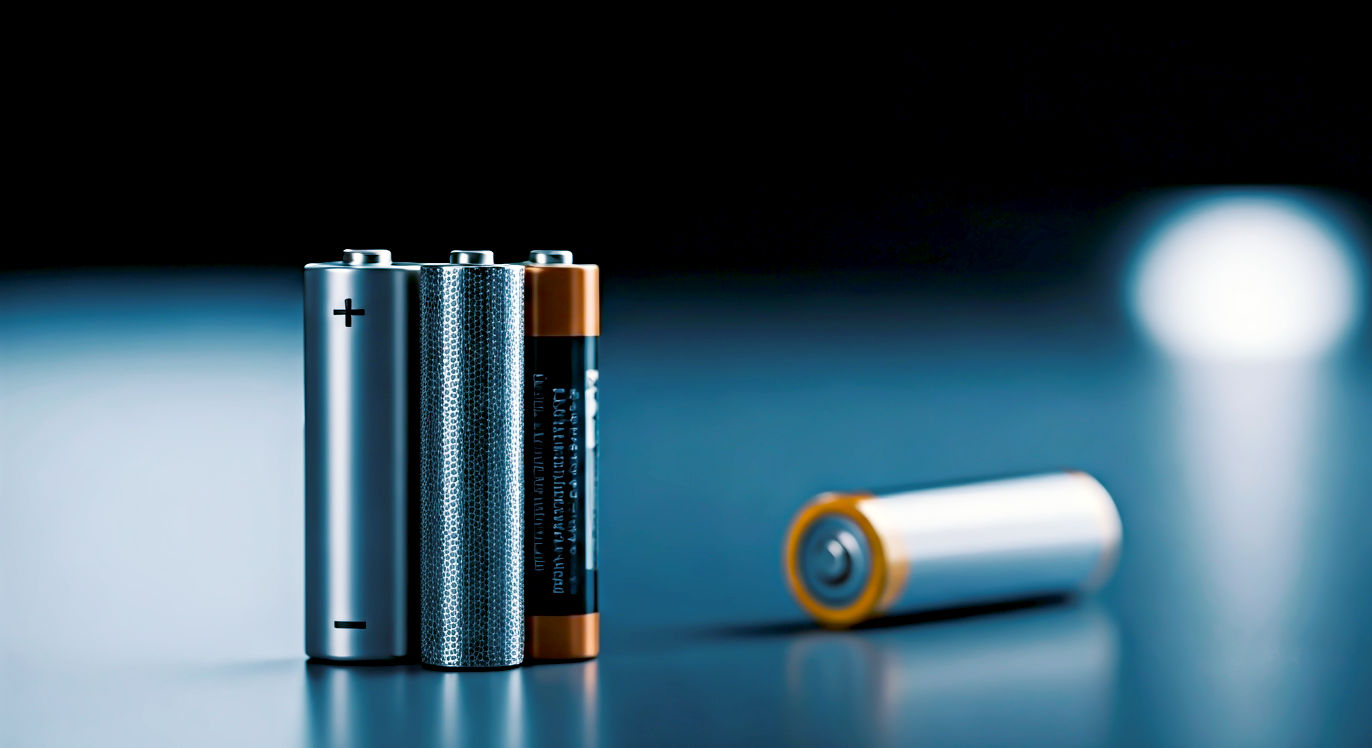The AA Battery Guide for UK Buyers: Powering Your Life the Smart Way
Confused by AA batteries? Our guide cuts through the jargon, comparing alkaline, lithium, and rechargeable batteries to help you save money and power your devices smarter.

This post may contain affiliate links. If you make a purchase through these links, we may earn a commission at no additional cost to you.
Let’s be honest, you probably don’t think about AA batteries until you really, really need one. It’s usually a moment of mild panic: the TV remote suddenly dies halfway through an episode of Gogglebox, a child’s favourite toy grinds to a silent halt, or your wireless mouse gives up the ghost right before a deadline. They’re the unsung, silent heroes of our homes, quietly powering the little gadgets that make modern life tick.
But when you stand in the aisle at Tesco or browse Amazon, the choice can be baffling. Alkaline, Lithium, Rechargeable, Super Heavy Duty… what does it all mean? Are the expensive ones really worth it? And are you just throwing money away by sticking with the same brand your parents always bought?
This isn’t just about avoiding another dead remote. Making a smart choice can save you a surprising amount of money, make your devices perform better, and even help the planet. Consider this your definitive, no-nonsense guide. We’ll cut through the jargon, bust some myths, and help you find the perfect AA battery for everything from your Xbox controller to your smoke alarm. From the science bit to the savvy shopping bit, you’re about to become a battery expert.
What Exactly Is an AA Battery? The Basics Explained
Before we dive into the deep end, let’s get the simple stuff straight. An AA battery, sometimes called a “double-A,” is a standard size of small, cylindrical battery. It’s been around for ages—since 1907, in fact—and became the world’s most common battery size for a reason: it strikes a great balance between power and size.
Think of a battery as a tiny, self-contained power plant. Inside its metal case, a chemical reaction happens that pushes electricity out of one end (the positive terminal, with the little nub) and pulls it back in through the other (the negative terminal, which is flat). When you pop it into a device, you complete a circuit, and that flow of electricity is what brings your gadget to life.
All standard AA batteries produce the same voltage, which is the ‘pressure’ of the electricity they push out. This is typically 1.5 volts (1.5V). However, rechargeable AA batteries are slightly different, usually offering 1.2 volts (1.2V). Don’t worry, this small difference is perfectly fine for almost every device designed for AAs.
The crucial difference between batteries isn’t their size or voltage, but what’s inside them. The chemicals used—the battery’s chemistry—determine everything: how long it lasts, how much power it can deliver at once, and whether you can charge it up again. This is where the real choice begins.
The Main Contenders: Alkaline vs. Lithium vs. Rechargeable
This is the big decision you’ll make at the shops. Almost all AA batteries sold in the UK fall into one of these three main categories. Each has its own strengths and is best suited for different jobs.
1. Alkaline Batteries: The Everyday Workhorse
If you picture an AA battery in your head, you’re probably thinking of an alkaline one. Brands like Duracell, Energizer, and supermarket own-brands are almost always alkaline. They are the go-to, disposable battery for most people.
- How they work: Alkaline batteries get their name from the alkaline electrolyte (a substance that conducts electricity) they use, typically potassium hydroxide. They generate power through a reaction between zinc and manganese dioxide.
- Best for: Low to medium-drain devices. These are gadgets that don’t need a huge surge of power and are used either intermittently or constantly draw a small amount of energy. Think TV remotes, clocks, wireless keyboards, and simple children’s toys.
- Pros:
- Cheap and widely available: You can buy them everywhere, from corner shops to massive online retailers.
- Good shelf life: A standard alkaline battery can sit in a drawer for up to 10 years and still be ready to use.
- Reliable performance for everyday items.
- Cons:
- Not great for high-power gadgets: In a power-hungry device like a digital camera flash or a high-performance torch, they can die very quickly.
- Prone to leaking: We’ve all seen it—that crusty white residue inside a forgotten toy. As alkaline batteries discharge, they can leak potassium carbonate, which can corrode and ruin your electronics.
- Single-use: Once they’re dead, they’re dead. This creates waste and means you have to keep buying more.
The verdict: Alkaline batteries are a solid, affordable choice for the vast majority of simple, low-power devices in your home. Just don’t expect them to keep up with demanding tech.
2. Lithium Batteries (Non-Rechargeable): The High-Performance Champion
These are the premium, single-use batteries. Don’t confuse them with the lithium-ion batteries in your phone—these are primary lithium batteries (meaning non-rechargeable) and they pack a serious punch. Energizer’s ‘Ultimate Lithium’ range is the best-known example.
- How they work: They use a lithium metal anode, giving them a much higher energy density than alkaline batteries.
- Best for: High-drain and critical devices. This is where you need maximum power, long life, and total reliability. Think digital cameras, high-powered LED torches, smoke alarms, and outdoor equipment used in cold weather.
- Pros:
- Incredible performance: They last much, much longer than alkaline batteries in high-drain devices—sometimes up to 8 times longer.
- Excellent in extreme temperatures: While alkaline batteries struggle in the cold, lithium batteries work brilliantly in freezing conditions, making them perfect for outdoor security cameras or GPS units for winter hiking.
- Extremely long shelf life: They can last for up to 20 years in storage.
- Lightweight: They are noticeably lighter than alkaline batteries.
- Leak-proof: Their construction makes them far less likely to leak and damage your expensive gear.
- Cons:
- Expensive: A pack of lithium AAs can cost three or four times as much as their alkaline equivalent.
- Still single-use: Despite their long life, they are still disposable, which isn’t great for the environment.
The verdict: For expensive, power-hungry, or essential safety equipment, lithium batteries are the undisputed king. The upfront cost is high, but for the right device, their performance and reliability are worth every penny. For a smoke alarm, where reliability is a matter of life and death, lithium is the smartest choice.
3. Rechargeable Batteries (NiMH): The Eco-Friendly, Long-Term Saver
Rechargeable batteries have been around for a while, but modern ones are a world away from the old ones you might remember. Today’s standard for rechargeable AAs is Nickel-Metal Hydride (NiMH). Brands like Panasonic Eneloop, Duracell Rechargeable, and Energizer Recharge lead the market.
- How they work: NiMH batteries use a hydrogen-absorbing alloy for the negative electrode and nickel oxyhydroxide for the positive one. You use them, they go flat, and you pop them in a charger to use them again… and again.
- Best for: Medium to high-drain devices that you use frequently. This is where they really shine and save you the most money. Perfect for Xbox or PlayStation controllers, wireless mice, digital cameras, baby monitors, and kids’ toys that get tons of use.
- Pros:
- Massive long-term savings: The initial cost is higher (you need batteries and a charger), but they can be recharged hundreds, sometimes even thousands, of times. The cost per use plummets to a fraction of a penny.
- Environmentally friendly: Reusing batteries drastically reduces the amount of waste going to landfill or recycling centres. It’s the greenest choice by a country mile.
- Excellent performance in high-drain devices: They can deliver a steady, high current, which power-hungry gadgets love. An Xbox controller will run for much longer on a set of good NiMH rechargeables than on standard alkalines.
- Modern versions come pre-charged: Many NiMH batteries are now “low self-discharge” (LSD), meaning they hold their charge for a long time in storage, just like a disposable battery. The Panasonic Eneloop range pioneered this.
- Cons:
- Higher initial cost: You have to buy the charger and the batteries upfront.
- Lower voltage (1.2V): While this works for over 99% of devices, very occasionally a sensitive device designed strictly for 1.5V alkalines might not work properly or may show a ‘low battery’ warning prematurely. This is rare but possible.
- They eventually wear out: After many hundreds of charge cycles, they will start to hold less power and will need to be replaced.
The verdict: For any device you use regularly, rechargeable NiMH batteries are the smartest, cheapest, and greenest choice in the long run. The initial investment pays for itself very quickly.
What About Zinc-Chloride (Heavy Duty) Batteries?
You might still see some batteries labelled “Heavy Duty” or “Super Heavy Duty,” often from lesser-known brands at bargain prices. These are based on an older technology called zinc-chloride.
Frankly, in 2025, you should avoid them. They are incredibly cheap but offer very poor performance and a short lifespan. They are a false economy. An alkaline battery will outperform them many times over for only a small extra cost. They are only suitable for the most basic, low-power items, like a simple wall clock, but even then, their tendency to leak makes them a risky choice.
Understanding the Numbers: Capacity (mAh) and Self-Discharge
When you start looking closely at battery packets, especially rechargeables, you’ll see some technical terms. The most important one is capacity, measured in milliampere-hours (mAh).
- What is mAh? Think of it as the battery’s fuel tank. A higher mAh number means the battery holds more energy and will, in theory, last longer before it needs replacing or recharging.
- A typical alkaline AA might have a capacity of around 2,000 to 2,500 mAh.
- A high-capacity rechargeable NiMH AA can be anywhere from 2,000 mAh to 2,800 mAh.
- A lithium AA has a capacity of around 3,000 to 3,500 mAh.
- Is bigger always better? Not necessarily. For a TV remote, which uses a tiny trickle of power, a super-high-capacity battery is overkill. You’re paying for performance you don’t need. However, for a power-hungry digital camera, that high mAh rating is exactly what you want.
Another key concept, mainly for rechargeables, is self-discharge. This is the tendency for a battery to lose its charge over time, even when it’s just sitting in a drawer.
- Standard NiMH batteries used to be terrible for this, losing up to 20% of their charge in the first day!
- Modern Low Self-Discharge (LSD) NiMH batteries are a game-changer. They will retain up to 85% of their charge even after a full year in storage. This makes them almost as convenient as disposable batteries. Always look for “low self-discharge” or “pre-charged” on the packaging.
The Right Battery for the Right Job: A Practical UK Buyer’s Guide
Okay, let’s put all that theory into practice. Here’s a simple cheat sheet for choosing the right AA battery for common household items.
| Device Type | Recommended Battery | Why? |
|---|---|---|
| TV Remotes, Clocks, Wireless Keyboards | Alkaline | These are classic low-drain devices. They need a small, steady supply of power over a very long time. Alkaline batteries are cheap and do this job perfectly. Rechargeables would work but might be overkill unless you have them anyway. |
| Kids’ Toys (Frequently Used) | Rechargeable NiMH | Toys, especially noisy, motorised ones, can chew through batteries at an astonishing rate. Using disposable alkalines will cost you a fortune. Rechargeables are the clear winner for your wallet and the planet. |
| Xbox/PlayStation Controllers | Rechargeable NiMH | Game controllers are a prime example of a high-drain, frequent-use device. A good set of NiMH batteries (like Panasonic Eneloop Pro) will give you long play sessions and save you a huge amount of money over time. |
| Digital Cameras & Flashes | Lithium (for performance) or High-Capacity NiMH (for value) | These devices need a huge burst of power very quickly. Lithium batteries excel here, giving you the fastest flash recycling times and most shots per set. High-capacity NiMH are a very close second and a much more economical choice for keen photographers. |
| Smoke & Carbon Monoxide Alarms | Lithium | Safety first. Smoke alarms are critical. You need a battery that is ultra-reliable, has a very long life, and won’t leak. Lithium is the only sensible choice. The ten-year lifespan of many lithium-powered alarms is often thanks to the battery inside. |
| High-Powered LED Torches & Headlamps | Lithium or Rechargeable NiMH | For the brightest output and longest runtimes, especially in the cold, lithium is best. For regular use, however, NiMH rechargeables provide excellent, consistent power and are more cost-effective. |
| Wireless Doorbells & Thermostats | Lithium | These devices are often exposed to the cold British weather. Lithium batteries are unaffected by low temperatures and have the long life needed for “fit and forget” applications. |
| Occasional-Use Items (e.g., emergency torch) | Alkaline or Lithium | For a torch that sits in a kitchen drawer for emergencies, you need a battery with a long shelf life. Both fit the bill, but lithium offers better performance and leak-proofing if you’re willing to pay more. |
Smart Shopping: Getting the Best Value for Your Money
- Don’t automatically buy big brands: While Duracell and Energizer make excellent batteries, independent tests by organisations like Which? have often found that supermarket own-brands (like those from Aldi, Lidl, and Ikea) can perform just as well for a fraction of the price, especially for alkaline batteries.
- Buy in bulk (if you’ll use them): Buying a multi-pack of 20 AA batteries is almost always cheaper per battery than buying a pack of four. But this only saves you money if you actually use them before they expire.
- Check the ‘best before’ date: Just like with food, batteries have an expiry date. Buying clearance-stock batteries that are nearly out of date isn’t a bargain.
- Invest in a good charger: If you go rechargeable, don’t cheap out on the charger. A good “smart” charger will charge each battery individually, prevent overcharging, and can even recondition older batteries. This will make your batteries last longer and perform better. Chargers from brands like Nitecore, XTAR, or Panasonic are excellent investments.
Battery Safety and a Greener Britain: How to Store and Recycle
Batteries are generally safe, but a little common sense goes a long way.
Storage Tips
- Store them in a cool, dry place. A hot conservatory or a damp shed is not an ideal home for your batteries.
- Keep them in their original packaging until you need them. This prevents the terminals from touching each other or other metal objects.
- Never carry loose batteries in your pocket, especially with keys or coins. This can cause a short circuit, making the battery heat up rapidly and potentially leak or even explode. A plastic battery case is a cheap and smart investment.
- Remove batteries from devices that you aren’t going to use for several months. This is the best way to prevent damage from leaks.
Recycling: Your Legal and Environmental Duty
You cannot and must not throw old batteries in your household bin. It’s illegal and terrible for the environment. When batteries end up in landfill, their casings can break down, and the heavy metals and corrosive chemicals inside can leak out and contaminate soil and groundwater.
Recycling batteries is easy and free. The UK has a well-established recycling network. You can find battery recycling points in:
- All major supermarkets (look for a collection tube or box, often near the entrance or customer service desk).
- Many smaller shops that sell batteries.
- Local council recycling centres (your local tip).
By law, any shop that sells more than 32kg of batteries a year (which is basically anywhere that sells multi-packs) has to provide a facility for you to return old ones for recycling. So next time you pop to the shops, just take your bag of dead batteries with you.
The Future of the AA
Is the trusty AA battery on its way out? Not any time soon. While many of our core gadgets like phones and laptops have moved to sealed, custom lithium-ion packs, the AA format is just too useful and versatile to disappear.
The biggest innovation on the horizon is the arrival of rechargeable Lithium-ion AA batteries. These are different from the single-use lithiums. They combine the 1.5V of a standard alkaline with the rechargeability of a NiMH and the power density of lithium-ion. Many even have a built-in USB-C port for easy charging. They are still quite new and expensive, but they represent an exciting next step in convenient, reusable power.
For now, though, the choice remains simple. For the low-power, everyday items, a good-quality alkaline is fine. For your essential safety gear and high-performance tech, lithium is the best. And for everything you use regularly, from game controllers to kids’ toys, a set of rechargeable NiMH batteries is the smartest, most sustainable, and most cost-effective decision you can make.
So next time the remote dies, you’ll know exactly what to do. You’re no longer just a battery buyer; you’re a power strategist.
Further Reading & Resources
- Which? UK: Offers independent and rigorous testing on a wide range of batteries. (Subscription may be required for full access).
- Recycle Your Electricals: A UK-based campaign with a postcode locator to find your nearest battery recycling point.
- The Battery University: An incredibly detailed technical resource for those who want to learn more about the science behind batteries.






